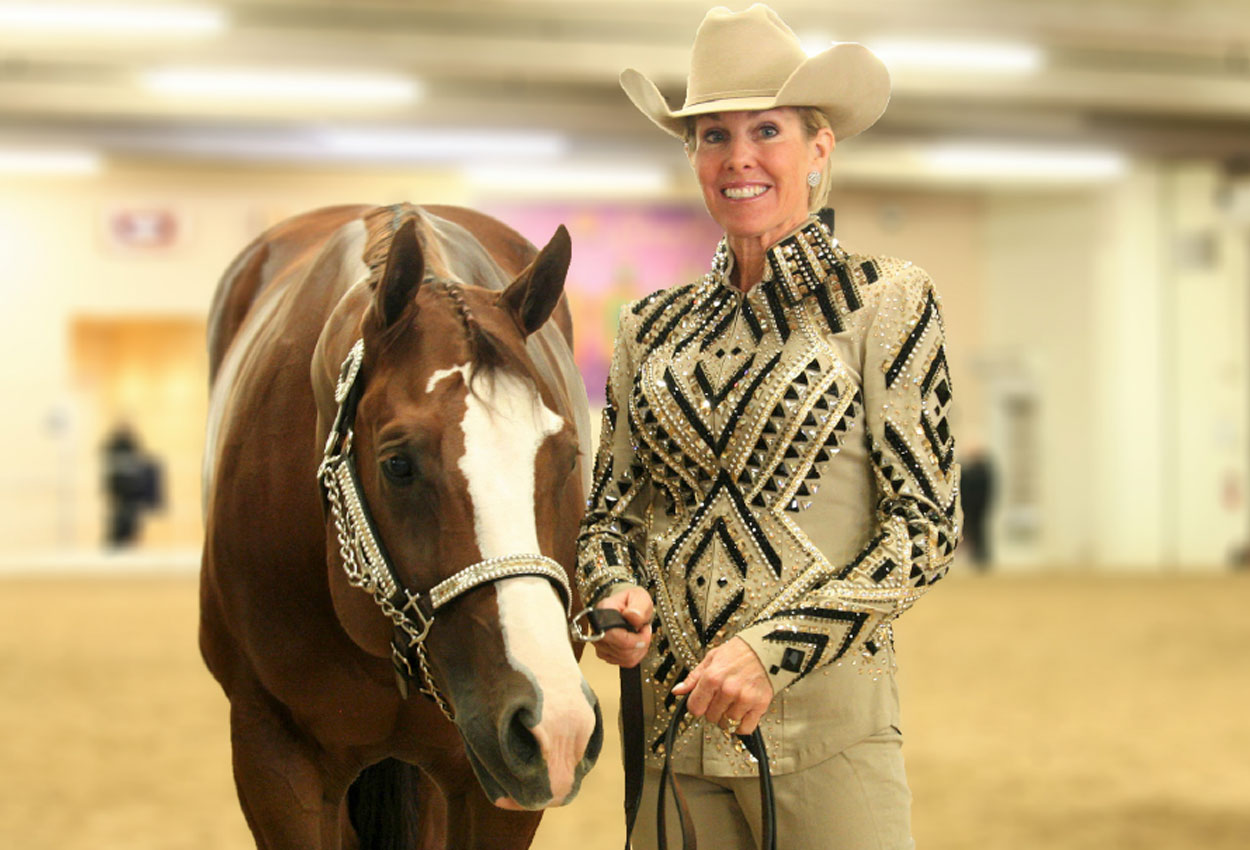
Showmanship with the Frids
Anyone who has ever donned boots, tight pants, and a glittery jacket, pulled their hair back in an unforgiving bun, applied a beauty queen’s amount of makeup, and did this all after bathing at midnight and getting up to school the pattern at 4:00 am, all to RUN beside their horse instead of riding him…is a Showmanship junkie.
Showmanship is not for the faint of heart, and professional husband and wife team Jenny Jordan and Robin Frid break down the various elements of the class and provide their insights, professional opinions, and methods on how to excel in this slightly crazy, yet completely addictive, class.
Should We Practice Every Day?
It depends on what your horse is really great at, regarding the various maneuvers. We don’t practice Showmanship every day. If you have a beginner horse that is just learning how to do the maneuvers, then work with that horse every day so it can learn. But for the horses that are already broke to the Showmanship and your goal is to be getting better at home, we suggest watching the 2017 Amateur Showmanship AQHA World Show finals. That was probably the toughest finals we’ve ever seen. The pattern was so challenging. There were great horses, and you could have looked at it a lot of different ways.
When at home, watch videos like the Amateur Finals and take note of what those exhibitors are doing and then take videos of yourself and compare yourself to the videos of the finals and what the top-level people are looking like in the show pen.
It is great to practice and be prepared, but be aware of the fact that you can over practice the Showmanship and it’s possible to turn a great Showmanship horse into a not so great one. You have to find a balance between working what needs work and what doesn’t, on a regular basis. You have to change it up for them. Even if some of the maneuvers are no longer part of the Rulebook. For example, if you just spin, spin, spin to the right you’re going to mess up that turn. So you need to change it up and keep them fresh, so use the pull turn just to keep the horse’s body in line and help make your push turn better so they don’t get bored with doing the same thing.
Lining Up Your Legs
We never teach a student to change their running stride to match their horse’s stride. The more you practice with your horse it will eventually happen, naturally. If you just practice running naturally it’s going to come together. Most times when somebody’s doing something slightly awkward it’s because they’re trying to match the stride of their horse and are not letting it come naturally. If you purposely try to match your horse’s stride, it’s going to end up looking awkward and not work.
The Trot
Let’s talk about the extended trot. If people try to alter their regular run and go slower and then they try to speed up their extended trot, it doesn’t work. You have to be a strong runner to be competitive in the Amateur Showmanship. You have to be athletic. You cannot be at the top if you cannot run well. The extended trot takes fitness, work and time and it is sometimes a bit scary. However, no matter your level of expertise or fitness, you have to do what your body is capable of doing. Our advice is to spend time running in the arena with or without your horse. There is no replacement for cowboy boots and dirt. We have people who work out four or five days a week tell us that they struggle running in the Showmanship sometimes.
The Arms and Hands
There is no perfect arm or hand placement. It’s different for everybody; depending on height, body shape and other factors. Keeping both arms even at all times is not necessarily important. However, you must have a confident left arm. It doesn’t matter exactly where your hand is located, as long as you are presenting your horse well and in a confident manner. However, never point free arm (left arm) downward or your twist your wrist. Not having good arm and hand position makes it look like the exhibitor’s mother is making them show in the class. You must possess good posture and presentation, stand up straight, and a have confident left arm.
Your arms don’t have to be glued to your sides, but they need to be tight. Especially if you’re a small person, it’s still important to keep your arms close to your body, but you don’t need to squish yourself, as that may cause your shoulders to come up. They just need to be comfortable by your side.
Set Up: The Head Set
The head set depends on where your horse is in their training. When your horse is still learning, sometimes the head has to be lower. In a dream world, you want that topline perfectly level, just like a hunt seat or pleasure horse. However, when you are teaching a young horse to be better, that height may have to change throughout the training process. When the horse is broke, you want it to be level.
When setting the hind foot, push back or pull forward and say “whoa” once the foot is placed. When you set up the front foot, you should do a totally different move like connecting with your hand on the lead and bumping with your hand. Be more assertive with the front feet than with the back feet. Sometimes youth and amateurs give the same cue for both the hind and front feet, which is confusing to the horse. You’re teaching this horse to move its body with a little lead shank. You have to be purposeful when you’re teaching your horse. Also, don’t teach the full set up at the same time. Work on the horse’s hind feet until they get really confident and really consistent in the way that you are cueing. Only after that should you introduce the front feet. You’d be moving your horse’s feet hundreds of times if you didn’t.
Always remember, especially when teaching he set up that close counts in the beginning.
Always have a look of confidence on your face. You don’t have to smile, but have the look that you know you’re doing well.
How Should I Be at the First Cone?
The First Cone
1. Focus on something and keep your horse’s body straight. You have to focus on being straight.
2. Show clothes and hats are important. You don’t have to be glitzy, but have an outfit that fits well and complements your body. Look polished. You need to have an outfit that when you put it on, you look in the mirror and say, “Man, I look good.”
3. Present at the cone- It’s your first impression. Your spacing from your horse and the way you’re holding your body is everything. You might have to stand closer or further away from your horse depending on the pattern, but don’t hide behind the horse.
As with any maneuvers, petting your horse is a positive. If you reward them they are going to learn better.
Show Horse Today
by Barbara Aitken Jenkins




